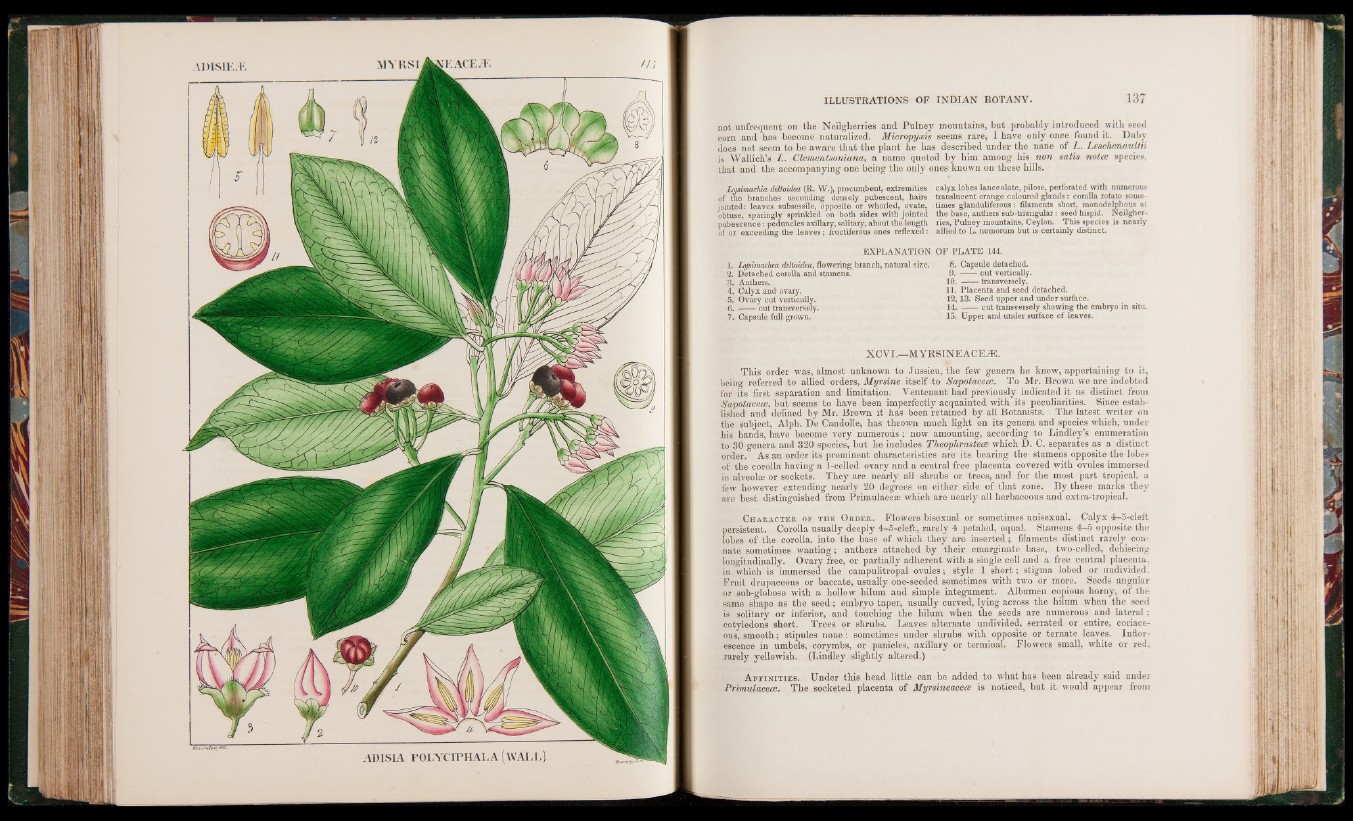
ILLUSTRATIONS OF INDIAN BOTANY. 137
not unfrequent on the Neilgherries and Pulney mountains, but probably introduced with seed
corn and has become naturalized. Micropyxis seems rare, I have only once found it. Duby
does not seem to be aware that the plant he has described under the nane of L. Leschenaulth
is Wallich’s L. Clementsoniana, a name quoted by him among his non satis notce species
that and the accompanying one being the only ones known on these hills.
Lysimackia deltoidea (R. W.), procumbent, extremities
of the branches ascending densely pubescent, hairs
jointed: leaves subsessile, opposite or whorled, ovate,
obtuse, sparingly sprinkled oh both sides with jointed
pubescence: peduncles axillary, solitary, about the length
of or exceeding the lea v e s; fructiferous ones reflexed:
EXPLANATION
1. Lyisimachea deltoidea, flowering branch, natural size.
2. Detached corolla and stamens.
3. Anthers.
4. Calyx and ovary.
5. Ovary cut vertically.
6. ------ cut transversely.
7. Capsule full grown.
calyx lobes lanceolate, pilose, perforated with numerous
translucent orange coloured glands: corolla rotate sometimes
glanduliferous: filaments short, monocle lpbous at
the base, anthers sub-triangular: seed hispid. Neilgherries,
Pulney mountains, Ceylon. This species is nearly
allied to L. nemorum but is certainly distinct.
OF PLATE 144.
8. Capsule detached.
9 . ------ cut vertically.
1 0 . ------ transversely.
11. Placenta and seed detached.
12,13. Seed upper and under surface.
14. —— cut transversely showing the embryo in situ.
15. Upper and under surface of leaves.
XCYI.—MYRSINEACEiE.
This order was, almost unknown to Jussieu, the few genera he knew, appertaining to it,
being referred to allied orders, Myrsine itself to Sapotacece. To Mr. Brown we are indebted
for its first separation and limitation. Yentenant had previously indicated it as distinct from
Sapotacece, but seems to have been imperfectly acquainted with its peculiarities. Since established
and defined by Mr. Brown it has been retained by all Botanists. The latest writer on
the subject, Alph. De Candolle, has thrown much light on its genera and species which, under
his hands, have become very numerous ; now amounting, according to Lindley’s enumeration
to 30 genera and 320 species, but he includes Theophrastece which D. C. separates as a distinct
order. As an order its prominent characteristics are its bearing the stamens opposite the lobes
of the corolla having a 1-celled ovary and a central free placenta covered with ovules immersed
in alveolae or sockets. They are nearly all shrubs or trees, and for the most part tropical, a
few however extending nearly 20 degrees on either side of that zone. By these marks they
are best distinguished from Primulaceae which are nearly all herbaceous and extra-tropical.
Character of the Order. Flowers bisexual or sometimes unisexual. Calyx 4-5-cleft
persistent. Corolla usually deeply 4-5-cleft, rarely 4 petaled, equal. Stamens 4-5 opposite the
lobes of the corolla, into the base of which they are inserted ; filaments distinct rarely connate
sometimes wanting; anthers attached by their emarginate base, two-celled, dehiscing
longitudinally. Ovary free, or partially adherent with a single cell and a free central placenta,
in which is immersed the campulitropal ovules; style 1 short; stigma lobed or undivided.
Fruit drupaceous or baccate, usually one-seeded sometimes with two or more. Seeds angular
or sub-globose with a hollow hilum and simple integument. Albumen copious horny, of the
same shape as the seed; embryo taper, usually curved, lying across the hilum when the seed
is solitary or inferior, and touching the hilum when the seeds are numerous and lateral;
cotyledons short. Trees or shrubs. Leaves alternate undivided, serrated or entire, coriaceous,
smooth; stipules none: sometimes under shrubs with opposite or ternate leaves. Inflorescence
in umbels, corymbs, or panicles, axillary or terminal. Flowers small, white or red,
rarely yellowish. (Lindley slightly altered.)
Affinities. Under this head little can be added to what has been already said under
Primulacece. The socketed placenta of Myrsineacece is noticed, but it would appear from